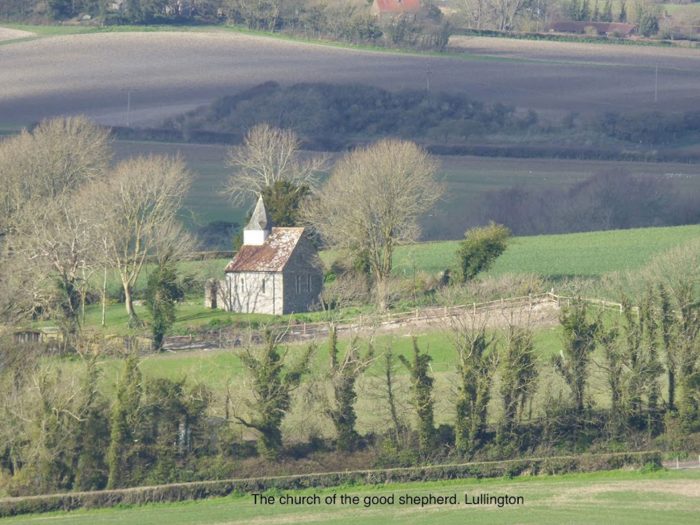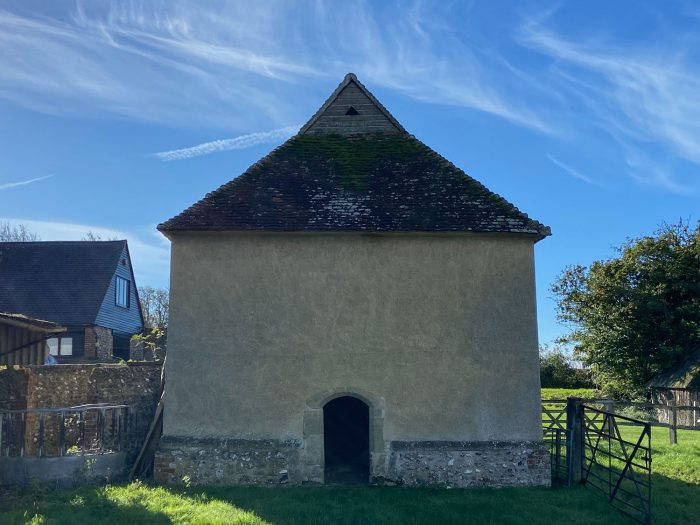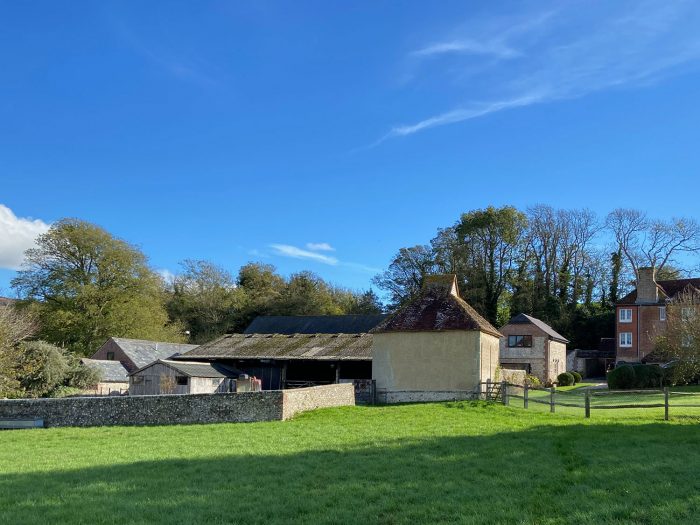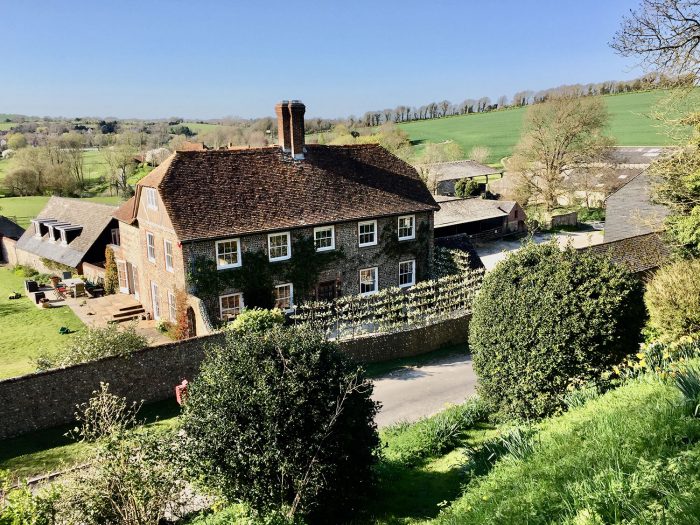The name Lullington most likely derives from the name of its one-time Saxon leader, the settlement of the people of Lulla.
At the time of the Norman Conquest Lullington was one of three small Saxon settlements in the Cuckmere Valley granted by William the Conqueror to his new religious foundation of Battle Abbey. The Abbey’s other Cuckmere lands were the small manor of Upper Clapham to the south of Lullington, and a significant proportion of the arable land in Alfriston across the Cuckmere River. All three were outliers of Alciston, Battle Abbey’s large manor to the west, to whom they reported. For nearly a hundred years, until the Abbey had established its own home farm at the end of the twelfth century, everything grown or produced by these manors was carted to Battle.
Over the course of 400 years of monastic administration power slowly shifted from the manor of Alciston to the manor of Lullington. Lullington would benefit from the growing prosperity of neighbouring Alfriston, which rapidly developed as a commercial centre in the fourteenth century. By 1360, Lullington had replaced Alciston as the Abbey’s administrative centre in the Cuckmere Valley. So, Lullington developed from a small Saxon hamlet centred on the hill, to a larger Norman-era manor with its own church supplying Battle Abbey, to a later fourteenth century manorial complex with a courthouse based at the bottom of the hill. This may explain its loose configuration.
The first step towards Lullington becoming the ‘parent’ of the three Cuckmere manors was in 1180 when the Abbot of Battle began construction of a church there for his Cuckmere tenants in Clapham, Lullington and Alfriston. Founded as a chapelry or subdivision of Alciston parish, the priest of Alciston presided there as needed. As such, Lullington Church had no dedicated priest, clergy house or church living until 1520.
Based on surviving rentals and court rolls between 1275 and 1539, local historian Juliet Clarke estimates fifteen tenant families at most living in Lullington at any one time during this period (a modest multiplier of four would give a population of sixty). This remains remarkably stable despite the start of the Hundred Years War with France in the 1330s, which saw frequent French assaults along the south coast, and successive poor harvests during the 1340s, which led to disease and starvation. In 1349, the Plague had also reached the south coast. Curiously, Battle Abbey chose this time of communal hardship to rebuild and enlarge Lullington church. Clarke suggests this may have been a power play between the Abbot and competing Alfriston landholders whose commercial interests had had to move inland from Seaford due to French raids. As Alfriston expanded and developed into the Valley’s commercial centre (with new opportunities and rewards on offer to the otherwise feudally constrained tenants of the Abbey), the complete re-building of Lullington’s church was likely an assertion of spiritual and territorial control in the area. It may also have reflected a larger congregation as the Abbey’s Alfriston land attracted more and more tenants.
By 1360, Battle Abbey had also decided to move its local manorial court from Alciston to Lullington and separated Lullington’s accounts from Alciston. A courthouse was added to the manorial compound that housed the farmer and his family at the bottom of the hill. This extended manor (known as Lullington Court from at least the eighteenth century onwards) was both a court where the Abbey’s tenants had to swear fealty, report infringements of the law, seek justice, and pay rents and fines, as well as the hub of a manor for the Abbey’s Cuckmere lands. However, the Abbey was fighting a losing battle against Alfriston’s growing prosperity not dependent on farming. Around 1360, the Church in Alfriston was rebuilt and this became the primary benefice of the valley. While Lullington’s importance may have been diminished by this, it retained the only operating local courthouse and – together with the farmland around Alfriston – continued to generate revenue for the Abbey.
During its late medieval peak, Lullington had three ‘built-up’ areas: the manorial complex; a roadside area five metres above the floodplain called Le Gore along the track leading to Alfriston; and a cluster of buildings around the church. At the heart of the manorial compound was the main building serving as the court. Outbuildings included a dovecote (which stands today) and the usual barns, bothies, stables and pigsties. The manor’s demesne included about 150 acres of arable and nearly 350 acres of downland grazing, along with river meadows, riparian rights, a very profitable fishery, woodland and a rabbit warren. It is probable that there was a watermill at the angle of Longbridge and Riverside Way and, later, a windmill above Lullington church, high up on the downland. Beyond the manorial compound, the next most prominent members of the community were the free tenants who had their farmhouses and barns above the floodplain in Le Gore. Just a little lower than the free tenants were the principal copyholders, so-called as tenants received a copy of the long manorial court rolls on which their tenancies were recorded. These copyholders had the most acreage and their houses lay along the riverbank. Court rolls from the 1320s to the 1350s suggest that this riverside area was intensively worked. It was part of the busy stretch either side of the Long Bridge with wharves, gravel beds, islands, watermills, reed beds, willows, eel traps and fisheries. The river would have been busy with boats, larger ships sailing up from the coast, and small craft for ferrying, particularly through the wet winter months. Complaints from riverside tenants about flooding and reed-choked ditches cease in the court rolls in the fifteenth century implying that that stretch of the bank was finally reconstructed and the road raised. The remaining half a dozen copyholders, those with just a few acres each, seem to have been living in a cluster of buildings around the church and ‘a green place called a sporting place or green’. In fourteenth century documents, trades and craftsmen were mentioned for Lullington including a tanner, two butchers, a cobbler, a baker, an ale-taster, and two so-called common brewers – women who brewed in larger quantities specifically for sale. However, most had ceased to function or moved to Alfriston by the end of the century.
A combination of the Black Death, which had hit Battle Abbey particularly hard, and new trends in agricultural production and the wool trade meant successive Abbots struggled to maintain the Abbey’s profitability. By the middle of the fifteenth century the Abbey could no longer keep its estates within the manorial system. In 1466, the manor of Lullington was leased out to yeoman Jeghelian Hounte, whose family maintained it as a profitable estate up until the Dissolution of the Monasteries under Henry VIII (1536-1541). Thomas Cromwell’s forces extracted all they could from Battle Abbey’s estates. The Abbey’s lands in Lullington and Alfriston were distributed or sold to private individuals, and new tenancies were granted. The manor of Lullington was confiscated in 1539 and within a year had been granted to, gentleman, John Mascall of Plumpton, along with its rents from Alfriston tenants. However, the court continued to function; no longer under the jurisdiction of the Abbey, but locally.
Thirty-two years later, Lullington Court was absorbed into the ever-expanding estates of the Sackville family of Knole House in Sevenoaks, Kent. Over the next two hundred years, Lullington evolved into two farming estates: Lullington Court Farm and Longbridge Farm. The former was based on the one-time manorial demesne with the addition of some tenantry or copyhold land including Plonke Farm. The manorial rights and responsibilities remained attached to the property in modified form. Court sessions were still held to collect rents owed, heriots and fines due on the exchange of tenancies, and generally to administer the properties on both sides of the river. The Lease of Lullington Court to William Woodhams in 1725, specifies that a ‘manorial court’ was to be held there once a year. Longbridge Farm was based on the freehold properties of Le Gore. Over time its owners acquired the rest of Lullington’s one-time copyhold acreage, piecemeal, as it became available. In 1839, Lady Plymouth, heir of the Sackville estates and owner of Lullington Court, bought Longbridge Farm back into the Sackville Estate although the two farms continued to operate separately.
The Sackvilles sold Lullington Court, including Court Farm, in 1897 to James Gwynne, who had also acquired Folkington Manor and Wooton. His aim, apparently, was to purchase all the land that could be seen from Folkington. James Gwynne’s son, Roland Gwynne, then of Folkington Manor and Mayor of Eastbourne and Chair of Sussex County Council, sold Lullington Court to William Grey Skinner of Pevensey in 1935. The next sale was in 1961, when Dick Ellis of Church Farm Litlington purchased Lullington Court from William Skinner’s widow. Dick Ellis sold the main house while retaining the farm and farm buildings. Thus, the one-time manorial demesne was dismantled, and Lullington Court became a separate, privately-owned house.
The actor and writer Dirk Bogarde famously spent several childhood summers in Lullington at the Old Rectory on the hill, which his parents rented as a holiday cottage between 1931 and 1933. Dirk and his sister Elizabeth were left largely in the care of their beloved nanny Lally during these holidays. In his memoir A Postillion Struck by Lightning (1977) he gives a lyrical account of these summers in Lullington, including his own excellent sketches and photographs of the area. It was so popular that he devoted another book Great Meadow (1992) exclusively to those summers. Great Meadow is the name of the field coming down the hill from the church to Lullington Court Farm. When his parents lost their bid to buy the Old Rectory at auction, they later rented a cottage on Winton Street on the opposite Down across the river in Alfriston.
After the War, the Old Rectory was acquired by Jeremy Hutchinson QC (1915-2017) and his then wife, the actress Peggy Ashcroft. Starting in the 1960s, Hutchinson made his reputation in high-profile obscenity trials. He was on the team that successfully defended Penguin Books, the publishers of Lady Chatterley’s Lover. He had cannily pushed for women jurors, later commenting “I’ve always taken the view that women are much more sensible about sex.” Immediately following the trial 20,000 copies were sold. Later, as a QC, his clients included Christine Keeler, who he confessed to finding “rather dull”, Soviet spy George Blake, the Great Train robber Charles Wilson, National Theatre Director Michael Bogdanov and the drugs-smuggler-turned-author, Howard Marks.
Hutchinson had earlier links to Sussex via Charleston House, the country seat of the Bloomsbury set. Both his parents – noted barrister, St John Hutchinson KC and Mary Hutchinson (nee Barnes) – were active members of the Bloomsbury set. His mother became the model for Virginia Woolf’s Mrs Dalloway and had a long affair with Woolf’s brother-in-law, the art writer Clive Bell. Hutchinson’s early career and marriage to Peggy were interrupted by World War Two. Juggling his pacifism with his hostility to Hitler, he volunteered for non-combatant service in the Royal Navy, and was wireless operator on board HMS Kelly. In 1941, HMS Kelly was sunk by a German bomber during the Battle of Crete. Floating in the water for hours before rescue, he sang to maintain morale and clung to wreckage alongside the ship’s commander, Lord Louis Mountbatten. Before he was rescued Peggy, who was then eight months pregnant, was told he had drowned.
Hutchinson became a Labour candidate in the 1945 general election taking on the safe Conservative seat of Westminster, encouraged by an Admiralty decision to give an extra month’s leave to anyone who stood for Parliament. He recalled knocking on the door of 10 Downing Street in a bid to canvass Winston Churchill. His driver on that occasion was a young firebrand named Tony Benn. In 1966, Hutchinson’s marriage to Peggy Ashcroft ended and he married a former nurse, June Osborn, widow of the concert pianist Franz Osborn. In 1978, he was created a Labour peer, Lord Hutchinson of Lullington but was the first Member of the Lords to resign his seat on account of being “too old”. A man of immense charm, wit and a love for the underdog, Jeremy Hutchinson was the model for John Mortimer’s character Rumpole of the Bailey and, like Hutchinson, referred to judges as “old darling”. One of Hutchinson’s best lines was delivered during his defence of Paul Ableman’s historical work, The Mouth and Oral Sex in a 1969 obscenity trial. The presiding judge asked a defence witness, the writer Margaret Drabble, why anyone needed to read about oral sex seeing as “We have managed to get on for a couple of thousand years without it.” In his closing speech to the jury, Hutchinson was sympathetic. “Poor His Lordship! Poor, poor His Lordship! Gone without oral sex for 1,000 years.”
Jeremy Nicolas Hutchinson died in 2017 at the splendid age of 102.



